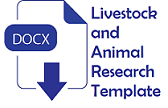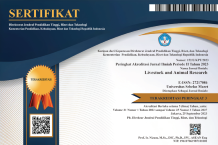Selection of Lactiplantibacillus plantarum strains as inoculant of rice straw fermentation and its fermentation characteristics
Abstract
Objective: This study aimed to select Lactiplantibacillus plantarum strains suitable for inoculant of rice straw fermentation and to evaluate its fermentation characteristics.
Methods: The experiment was conducted at the Feed Bioprocess Laboratory, Research Center for Applied Zoology, National Research and Innovation Agency (BRIN). This experiment was designed using a 3×4 factorial arrangement in a completely randomized design (CRD). The first factor was inoculant (1%), and the second was incubation time (7, 14, 28, and 58 days). The first stage was selection of 9 strains of L. plantarum, based on the ability to lowering the pH and produce lactic acid. The second stage was observing the growth curve of the selected strains of L. plantarum as inoculant for rice straw fermentation. The third stage was monitoring of the rice straw fermentation characteristics, including pH values, concentration of lactic acid, water-soluble carbohydrates (WSC) and NH3-N, also dry matter, ash and crude protein. Data were analyzed based on analysis of variance, and if there was a significant effect, the data were further analyzed with Duncan’s Multiple Range Test.
Results: The selected strains L. plantarum Ca098 and L. plantarum 1A-2 showed significant interaction result (p<0.05) compared with treating inoculant and ensiling days. The fermentation time influenced (p<0.05) the quality of rice straw fermentation including pH, concentration of lactic acid, WSC, NH3-N, and crude protein.
Conclusions: L. plantarum Ca098 showed the best rice straw fermentation characteristics, with fleigh value of 163.86±5.97 at 58 days of fermentation. L. plantarum Ca098 showed the highest lactic acid, the lowest pH and improve crude protein content.
Keywords
Full Text:
PDFReferences
- Rosmiza, M. Z., W. P. Davies, A. C. R. Rosniza, M. Mazdi, and M. Jabil. 2014. Farmers’ knowledge on potential uses of rice straw: an assessment in MADA and Sekinchan, Malaysia. Malay. J. Soc. Space. 10(5):3-43.
- Darsani, R. Y. and Koesrin. 2018. Preferensi petani terhadap karakter beberapa varietas unggul padi lahan rawa pasang surut. Penelitian Pertanian Tanaman Pangan. 2(2):85-94. Doi: 10.21082/jpptp.v2n2.2018. p85-94
- Rhofita, E. I. 2015. Study of the utilization of rice straw waste in the upstream. J. Environ. Eng. 1(2):1-6. Doi: 10.1016/j.jobab.2020.07.001
- Carvalho, B. F., C. L. S. Avila, M. G. C. P. Miguel, J. C. Pinto, M. C. Santos, and R. F. Schwan. 2015. Aerobic stability of sugar-cane silage inoculated with tropical strains of lactic acid bacteria. Grass Forage Sci. 70:308-323. Doi: 10.1111/gfs.12117
- Pereira, G. V. M., D. P. C Neto, A. B. P Medeiros, V. T. Soccol, E. Neto, A. L. Woiciechowski, and C. R. Soccol. 2016. Potential of lactic acid bacteria to improve the fermentation and quality of coffee during on‐farm processing. Int. J. Food Sci. Tech. 51(7):1689-1695. Doi: 10.1111/ijfs.13142
- Yang, F., Y. Wang, S. Zhao and Y. Wang. 2020. Lactobacillus plantarum inoculants delay spoilage of high moisture alfalfa silages by regulating bacterial community composition. Front. Microbiol. 11:1989. Doi: 10.3389/fmicb.2020.01989
- Goodman, B. A. 2020. Utilization of waste straw and husks from rice production: A review. J. Bioresour. Bioprod. 5:143–162. Doi: 10.1016/j.jobab.2020.07.001
- Ridwan, R., I. Rusmana, Y. Widyastuti, K. G. Wiryawan, B. Prasetya, M. Sakamoto, and M. Ohkuma. 2015. Fermentation characteristics and microbial diversity of tropical grass-legumes silages. Asian-Australas J. Anim. Sci. 28:511–518. Doi: 10.5713/ajas.14.0622
- Kim, J. G., J. S. Ham, Y. W. Li, H. S. Park, C-S. Huh, and B-C Park. 2017. Development of a new lactic acid bacterial inoculant for fresh rice straw silage. Asian-Australas J. Anim. Sci. 30(7):950-956. Doi: 10.5713/ajas.17.0287
- Carvalhoa, B. F., C. L. S Ávila, J. C. Pinto, J. Neri, and R. F. Schwan. 2014. Microbiological and chemical profile of sugar cane silage fermentation inoculated with wild strains of lactic acid bacteria. Anim. Feed Sci. Technol. 195:1-13. Doi: 10.1016/j.anifeedsci.2014.04.003
- Borshchevskaya, L. N., T. L. Gerdeeva, A. N Kalinina, and S. P. Sineokii. 2016. Spectrophotometric determination of lactid acid. J. Anal. Chem. 70(8):755-758. Doi: 10.1134/51061934816080037
- Cappuccino, J. G. and N. Sherman. 2017. Microbiology; a laboratory manual. 11th edn. In: State University of New York (ed) Rockland Community College, NY, USA. p. 121-127.
- John, A., G. Barnett, and T. B. Miller. 1950. The determination of soluble carbohydrate in dried samples of grass silage by the anthrone method. J. Sci. Food Agric. 1(11): 336-339. Doi 10.1002/jsfa.2740011106
- Souza N. K. P., E. Detmann, S. C. Valadares Filho, V. A. C. Costa, D. S. Pina, D. I. Gomes, A. C. Queiroz, and H. C. Mantovani. 2013. Accuracy of the estimates of ammonia concentration in rumen fluid using different analytical methods. Arq. Bras. Med. Vet. Zootec. 65:1752–1758. Doi: 10.1590/S0102-09352013000600024
- AOAC. 2019. Official methods of analysis. 21th ed. Assoc. Off. Anal. Chem., Arlington, VA.
- Idikut, L., B. A. Arikan, M. Kaplan, I. Guven, A.I. Atalay, and A. Kamalak. 2009. Potential nutritive value of sweet corn as a silage crop with or without corn ear. J. Anim. Vet. Adv. 8(4):734-741.
- Steel, R. G. and J. H. Torrie. 1980. Analysis of covariance. Principles and procedures of statistics: A Biometrical Approach. McGraw-Hill Book Company, Inc., NY. p. 401-437.
- Wang, J., Q. Wang, Z. Xu, W. Zhang, and J. Xiang. 2015. Effect of fermentation conditions on lactic acid production from soybean straw hydrolysate. J. Microbiol. Biotechnol. 25(1):26–32. Doi: 10.4014/jmb.1405.05025
- Contreras-Goveaa, F. E., R. E. Muck, G. A. Broderick, and P. J. Weimer. 2013. Lactobacillus plantarum effects on silage fermentation and in vitro microbial yield. Anim. Feed Sci. Technol. 179:61–68. Doi: 10.1016/j.anifeedsci.2012.11.008
- Hapsari, S. S., Suryahadi, and H. A. Sukria. 2016. Improvement on the Nutritive Quality of Napier Grass Silage through Inoculation of Lactobacillus plantarum and Formic Acid. Med. Pet. 39(2):125-133. Doi: 10.5398/medpet.2016.39.2.125
- Sari, N. F., R. Ridwan, and Y. Widyastuti. 2017. The quality of corn silage product from Technopark of Banyumulek Lombok, West Nusa Tenggara. Buletin Peternakan, 41(2):156-162. Doi: 10.21059/buletinpeternak.v41i2.15513
- Sarwono, K. A., R. Rohmatussolihat, M. Watman, S. Ratnakomala, W. D. Astuti, R. Fidriyanto, R. Ridwan, and Y. Widyastuti. 2022. Characteristics of fresh rice straw silage quality prepared with addition of lactic acid bacteria and crude cellulase. AIMS Agric. Food, 7(3): 481–499. Doi: 10.3934/agrfood.2022030
- Whiter, A. G. and L. Kung Jr. 2012. The effect of a dry or liquid application of Lactobacillus plantarum MTD1 on the fermentation of alfalfa silage. J. Dairy Sci. 2001;84:2195-202. Doi: 10.3168/jds.S0022-0302(01)74666-8.
- Holzapfel, W. H. and B. J. B. Wood. 2014. Lactic acid bacteria in contemporary perspective. Dalam Wood, B. J. B dan W. H. Holzapfel (ed). The Genera of Lactic Acid Bacteria, Blackie Academic & Professional, London. p. 1-6.
- Heinritz, S. N., S. D. Martens, P. Avila, and S. Hoedtke. 2012. The effect of inoculant and sucrose addition on the silage quality of tropical forage legumes with varying ensilability. Anim. Feed Sci. Tech. 174: 201-210. Doi: 10.1016/j.anifeedsci.2012.03.017
- Oliveira, A. S., Z. G. Weingberg, I. M. Ogunade, A. A. P. Cervantes, K. G. Arriola, Y. Jiang, D. Kim, X. Li, M. C. M. Gonçalves, D. Vyas, and A. T. Adesogan. 2017. Meta-analysis of effects of inoculation with homofermentative and facultative heterofermentative lactic acid bacteria on silage fermentation, aerobic stability, and the performance of dairy cows. J. Dairy Sci. 100:4587–4603. Doi: 10.3168/jds.2016-11815
- Zhao, J., Z. Dong. J. Li, L. Chen, Y. Bai, Y. Jia, and T. Shao. 2019. Effects of lactic acid bacteria and molasses on fermentation dynamics, structural and nonstructural carbohydrate composition and in vitro ruminal fermentation of rice straw silage. Asian-Australas J. Anim. Sci. 32(6):783-791. Doi: 10.5713/ajas.18.0543
- Hoffmann, F., M. G. B. Pagnoncelli, L. R. R. Mayer, A. C. Fluck, R. Macagnan, P. C. Taraves. L. Zorzi, and W. F. Almeida, 2019. Lactobacillus plantarum LPBR01 as inoculant in sugar cane silage. J. Anim. Sci. 41(04):2-7. Doi: 10.4025/actascianimsci.v41i1.45708
- McDonald, P., R. A. Edwards, J. F. D. Greenhalgh, C. A. Morgan, L. A. Sinclair and R. G. Wilkinson. 2022. The nutritional characteristics of foods: silage. In: Animal nutrition. Eight edition. Pearson. Harlow, England. p. 521-542.
- Naibaho, T. Despal, and I. G. Permana. 2017. Perbandingan silase ransum komplit berbasis jabon dan jerami untuk meningkatkan ketersediaan pakan sapi perah berkualitas secara berkesinambungan. Buletin Makanan Ternak 104(2):12-20.
Refbacks
- There are currently no refbacks.










